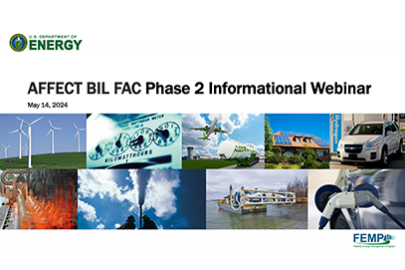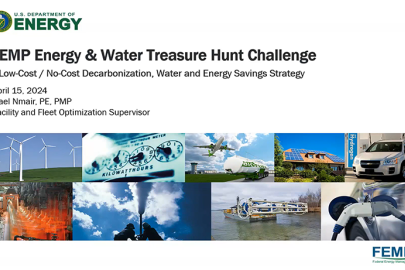Video outlines EV types and driving ranges, regenerative braking and drivetrain modes, electric vehicle supply equipment, and EV energy consumption.
Federal Energy Management Program
June 28, 2022Electric vehicle (EV) technology has advanced rapidly since its introduction, and today there are many plug-in hybrid and battery EV options available on the market. But how do EVs work and what are their advantages? In this video you'll learn about different EV types and their driving ranges, regenerative braking and drivetrain modes, electric vehicle supply equipment, and EV energy consumption and reporting.
Part 1: Vehicle Overview
Electric vehicle technology has advanced rapidly since its introduction, and today there are many plug-in hybrid and battery electric vehicle options available on the market. But how do electric vehicles work and what are their advantages? Let's start by considering the legacy vehicle technology: the internal combustion engine. This vehicle is propelled by a combustion engine that can only be fueled by gasoline. The technology is conventional, well-established, and reliable, but it consumes large amounts of gasoline—which can be costly in many ways.
Enter the electric vehicle drivetrain! Unlike internal combustion technology—which uses combustion and pressure to propel a vehicle—electric vehicles, or EVs, are propelled by electromagnetism. These vehicles use electricity, typically stored in a battery, to power an electric motor. EV technology is used in hybrid electric vehicles, plug-in hybrid electric vehicles, and battery electric vehicles. The hybrid electric vehicle was the first EV technology to reach the modern vehicle market. Hybrid electric vehicles, such as the Toyota Prius, are popular because of their increased fuel efficiency. These vehicles combine an internal combustion engine and an electric motor with a small battery for storing electricity. Although a hybrid electric vehicle is only fueled by gasoline, the vehicle's battery is also used to power the electric motor. The electricity stored in the battery primarily comes from recapturing energy through regenerative braking. This use of recaptured energy is one of the reasons a hybrid electric vehicle is more fuel-efficient than a typical internal combustion engine vehicle.
Like the original hybrid, the plug-in hybrid electric vehicle is propelled by an internal combustion engine and an electric motor. However, the plug-in hybrid electric vehicle has a much larger battery pack that can be charged using EV charging equipment. This enables the vehicle to operate in all-electric mode—in which the vehicle is propelled using only the electric motor—until the battery is mostly depleted. At this point the vehicle operates in hybrid mode until the battery can be recharged. Increasing the battery size and running the vehicle on electricity reduces tailpipe emissions and increases the vehicle's fuel- and energy-efficiency.
The final type of electric vehicle technology is the battery electric vehicle. This vehicle has no internal combustion engine and is powered only by the battery and electric motor. Battery electric vehicles don't use gasoline and are only charged by EV charging equipment. A battery electric vehicle has the largest battery of all the vehicle types. It's also the most energy efficient and produces zero tailpipe emissions.
Part 2: Vehicle Ranges
Because each vehicle type incorporates different technologies, the range these vehicles can travel differs as well. Internal combustion engine vehicles—fueled only on gasoline—typically can travel 350 to 450 miles on a full tank of gas.
Hybrid electric vehicles are more efficient in their use of gasoline and typically can travel 550 to 700 miles. Although they do have a battery and electric motor, this battery is only fueled during a typical drive cycle and is not a primary source of propulsion. However, due to regenerative braking, this small battery is the primary reason for the hybrid's increased fuel efficiency and range. The larger battery in a plug-in hybrid electric vehicle enables the vehicle to operate in all-electric mode, typically traveling 20 to 40 miles just on electricity. Plug-in hybrid electric vehicles are designed to support average daily commutes and easy overnight recharging using a standard outlet. After most of the energy in the battery is depleted, the vehicle can operate in hybrid mode for longer distances, running off gasoline and using a small portion of the battery to support the electric drivetrain, for a full vehicle range of 450 to 550 miles.
Finally, a battery electric vehicle has the simplest and most efficient drivetrain with a typical battery range of 150 to 300 miles. Battery electric vehicles can be charged overnight using a standard residential Level 2 EV charger.
Part 3: EV Regenerative Braking Modes
The most noticeable difference between driving an electric vehicle and a conventional vehicle is regenerative braking. Regenerative braking means the electric motor is operated in reverse, thereby applying a braking force through electromagnetism. This recaptures some of the vehicle's kinetic energy by charging the battery. Some electric vehicle models have specific driving modes that incorporate varying levels of regenerative braking.
Under normal driving conditions, an EV engages regenerative braking to slow the vehicle when the driver removes their foot from the accelerator. The “Standard” setting provides the maximum amount of regenerative braking power— it recaptures the most energy and reduces wear and tear on the brakes.
Alternately, the “Low” setting incorporates a reduced regenerative braking force that recaptures less energy but allows the vehicle to coast farther than in the “Standard” mode.
EVs also have specific settings for how the braking systems operate when the vehicle is stopped or moving at very low speeds. The “Creep” mode is designed to replicate the idling speed of an internal combustion engine vehicle. It disengages regenerative braking and applies a small amount of motor torque when stopped, or at low speeds when the driver's foot is off the accelerator. This feature is most commonly used in a parking lot when searching for a place to park.
Alternately, the “Roll” setting also disengages regenerative braking at low speeds but does not apply motor torque. This allows the vehicle to roll freely, similar to a vehicle in neutral.
Finally, the “Hold” setting continues to engage regenerative braking until the vehicle comes to a complete stop, which helps reduce brake wear and produces the greatest amount of recaptured energy. This feature also automatically engages the friction brakes when the vehicle is completely stopped, holding the vehicle in place until the driver's foot is placed on the brake or the accelerator. In all of these braking modes, the brake pedal is always available and operates the same way as in a conventional vehicle under emergency braking conditions.
Regenerative braking modes vary with each vehicle make and model. For example, the Nissan Leaf provides three levels of regenerative braking modes, and the Chevrolet Bolt's system involves depressing paddles next to the steering wheel to maximize regenerative braking and bring the vehicle to a complete stop.
Part 4: Plug-In Hybrid Electric Vehicle Drivetrain Modes
With two completely separate drivetrains—electric and combustion—plug-in hybrid electric vehicles can incorporate regenerative braking and also operate under many different driving modes. Some plug-in hybrid electric vehicles require the driver to select “electric mode” to drive the vehicle using electric miles. For those vehicles, additional driver training and guidance may be needed. Drivers can select the electric mode at the beginning of a trip to maximize electric miles driven.
Part 5: EV Charging Equipment Types
All plug-in electric vehicles, including plug-in hybrids and battery electric vehicles, use EV charging equipment to charge their batteries.
There are three common types of EV chargers. The first is referred to as a Level 1 charger. Typically, these units are portable cordsets that run off a standard 120-volt household outlet, and provide approximately 2 to 5 miles of range per hour of charging. This is the most affordable type of charger, but it is limited in the daily range it can supply to a vehicle. Therefore, this application is most common for plug-in hybrid electric vehicles with smaller batteries, or for battery electric vehicle drivers with shorter daily miles.
Level 2 chargers provide more energy per hour and run off 208 or 240 volts. These chargers are more expensive and are typically installed as permanent pedestal-style or wall-mounted units. They provide a vehicle with approximately 25 miles of range per hour of charging. This is the most common application for long-range battery electric vehicles, as well as fleet, workplace, and public charging stations.
Finally, a DC Fast Charger is the most expensive type of charger, but it provides the most energy per hour to the vehicle. A standard DC Fast Charger can provide 100 to 200-plus miles of range in about 30 minutes. These chargers can support occasional long-distance trips or fleet vehicles with limited dwell time that need to recharge in a short period of time.
Part 6: Reporting Energy Consumption
For federal fleet vehicles, reporting energy consumption is a requirement of doing business. With internal combustion engine vehicles, fuel consumption is typically reported through the fuel card provider that records each fueling transaction.
However, electric vehicles can be charged on-site or off-site at wall outlets, simple EV charging units, and networked units. Although many of these charging units can record and store transactions, some of the most-affordable EV chargers may not. Therefore, the recommended method for measuring energy consumption—expressed in kilowatt-hours—is through telematics.
Telematics platforms commonly capture kilowatt-hours and display them in an online dashboard. A fleet manager can select a custom date range to find a vehicle's energy consumption in kilowatt-hours over a certain time period. This date range can be applied to all of the electric vehicles in a fleet, providing the information necessary for annual federal fleet reporting.
Networked or smart-EV charging units are another good source of energy consumption information. These units frequently have online dashboards, similar to telematics, that capture energy consumption by vehicle. These dashboards are often accessible through smart phone applications as well. However, if the vehicle is occasionally charged on another network, the data from the primary EV charging unit may be incomplete. In this case, drivers should try to collect information from off-site charging stations to supplement the data from their primary EV charging unit.
The vehicles themselves also often display energy consumption or vehicle efficiency on their physical dashboard. Some vehicle models show lifetime energy consumption, so federal fleet managers will need to check the kilowatt-hours consumed annually to complete their FAST reports. However, if the vehicle displays the lifetime efficiency in miles per kilowatt-hour, fleet managers will need to divide the annual vehicle miles traveled by the vehicle efficiency to determine annual energy consumed.
If all else fails, the U.S. Department of Energy's Federal Energy Management Program has a simple way to estimate vehicle energy consumption: Take the vehicle's annual mileage reading and multiply it by the vehicle's fuel economy, listed in kilowatt-hours per mile on FuelEconomy.gov.
Part 7: Conclusion
Now that you know all about EV types, driving ranges, regenerative braking, drivetrains, and charging, you are ready to drive your new electric vehicle!
Learn more about FEMP Electric Vehicle Training.
More Videos
-
 This Take Five training covers the why and how of life cycle costing, comparison of life cycle cost savings for different energy-using products, and ensuring that products are cost effective.
This Take Five training covers the why and how of life cycle costing, comparison of life cycle cost savings for different energy-using products, and ensuring that products are cost effective. -
 This Take Five training provides an overview of energy efficiency guidelines for food storage and equipment for federal employees and food-service contractors.
This Take Five training provides an overview of energy efficiency guidelines for food storage and equipment for federal employees and food-service contractors. -
 REopt helps federal building owners and energy managers identify and understand the optimal energy solution for their facility or campus.
REopt helps federal building owners and energy managers identify and understand the optimal energy solution for their facility or campus. -
 Learn how to use the Electric Vehicle Infrastructure – Locally Optimized Charging Assessment Tool and Estimator (EVI-LOCATE) web tool to guide you through the electric vehicle (EV) charging station planning process.
Learn how to use the Electric Vehicle Infrastructure – Locally Optimized Charging Assessment Tool and Estimator (EVI-LOCATE) web tool to guide you through the electric vehicle (EV) charging station planning process. -
 The Electric Vehicle Infrastructure – Locally Optimized Charging Assessment Tool and Estimator (EVI-LOCATE) website guides you through an interactive site assessment process and generates cost estimates and site layouts for EV charging projects.
The Electric Vehicle Infrastructure – Locally Optimized Charging Assessment Tool and Estimator (EVI-LOCATE) website guides you through an interactive site assessment process and generates cost estimates and site layouts for EV charging projects. -
 This webinar recording walks through the best practices for submitting an AFFECT application.
This webinar recording walks through the best practices for submitting an AFFECT application. -
 Webinar provides overview about Phase 2 of the Assisting Federal Facilities with Energy Conservation Technologies (AFFECT) Bipartisan Infrastructure Law (BIL) Federal Agency Call (FAC).
Webinar provides overview about Phase 2 of the Assisting Federal Facilities with Energy Conservation Technologies (AFFECT) Bipartisan Infrastructure Law (BIL) Federal Agency Call (FAC). -
 This informational webinar, hosted by the Federal Energy Management Program (FEMP), marks the launch of the 2024 FEMP Re-tuning Challenge.
This informational webinar, hosted by the Federal Energy Management Program (FEMP), marks the launch of the 2024 FEMP Re-tuning Challenge. -
 This webinar describes the foundational principles of the Federal Energy Management Program's (FEMP) Regional Energy and Water Treasure Hunt Program and helps agencies recognize no-cost, low-cost energy and water savings opportunities.
This webinar describes the foundational principles of the Federal Energy Management Program's (FEMP) Regional Energy and Water Treasure Hunt Program and helps agencies recognize no-cost, low-cost energy and water savings opportunities. -
 This training session provides an overview of how to complete the ePB template for different funding types, shows where to enter the AFFECT grant value, and describes how the information in key tabs will be used during the evaluation process.
This training session provides an overview of how to complete the ePB template for different funding types, shows where to enter the AFFECT grant value, and describes how the information in key tabs will be used during the evaluation process.

